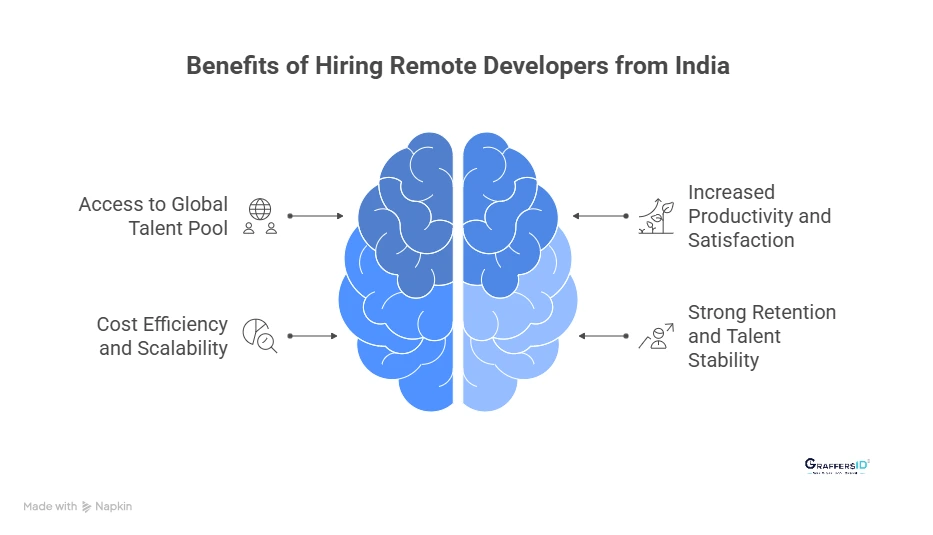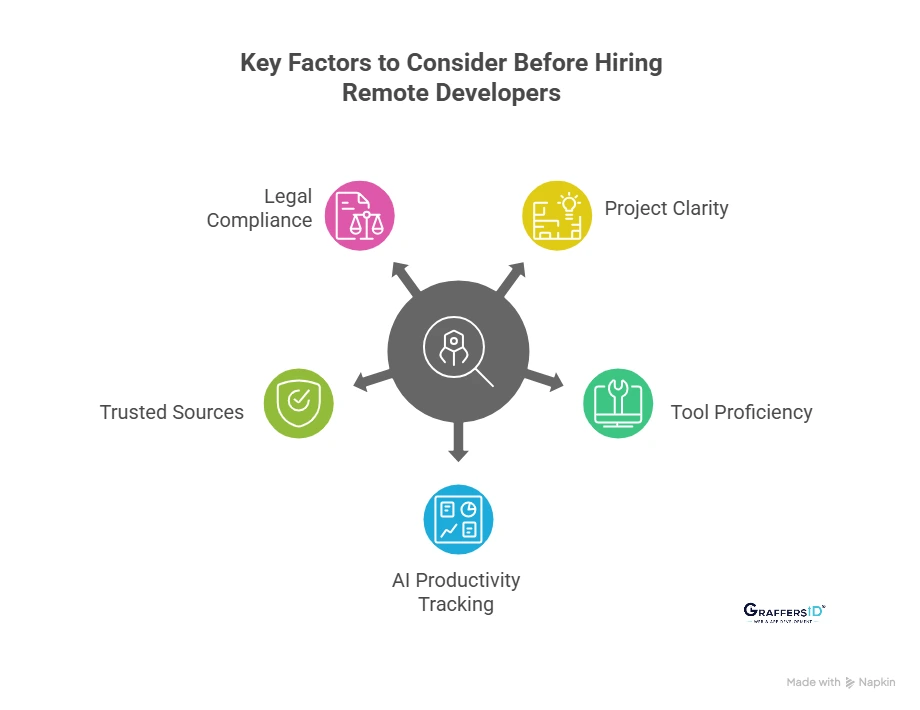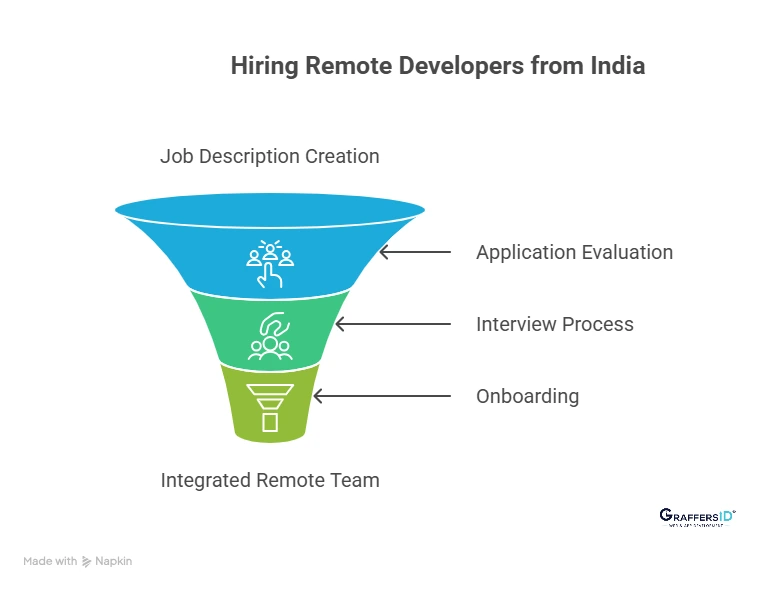In 2026, remote hiring has transformed from a pandemic-born necessity into a core business growth strategy. For today’s CTOs, founders, and tech leaders, the question is no longer “Should we hire remotely?” It’s “How do we build high-performing global teams faster, smarter, and more cost-effectively?”
With the rise of AI-powered hiring platforms, automation-driven onboarding, and real-time collaboration tools, companies can now access world-class developers across continents with just a few clicks. Among all destinations, India stands out as the global hub for remote software talent, offering a powerful blend of technical depth, scalability, cultural adaptability, and cost efficiency.
In this guide, we’ll walk you through every essential step of hiring remote developers from India in 2026, from understanding the key benefits and hiring models to leveraging AI-driven recruitment tools, compliance strategies, and trending tech stacks so you can hire the best Indian developers with confidence and clarity.
Evolution of Remote Hiring in 2026
Remote hiring has officially matured into a core business model, especially in technology-driven sectors. What started as an adaptation during the 2020 pandemic is now an intentional talent strategy.
Read More: Remote Hiring vs. In-House Hiring: Which Is Better for Tech Startups?
According to 2026 reports by Deloitte and Gartner:
-
Over 82% of global tech firms employ at least part of their workforce remotely.
-
India ranks #1 globally for outsourced and remote developer talent.
-
The use of AI and automation tools (like Deel, Remote, and Rippling) has reduced global onboarding time by 40%.
Companies no longer view remote work as a temporary solution but as a scalable hiring model that boosts productivity, innovation, and cost efficiency.
Why Hire Remote Developers from India? Key Benefits for Global Companies in 2026
India has become one of the top destinations for hiring remote developers due to its vast talent pool, technical expertise, and cost advantage. Each year, India produces over 1.5 million skilled software engineers trained in the latest technologies, such as AI, machine learning, cloud computing, blockchain, and full-stack development.
Here’s why global companies prefer hiring remote developers from India in 2026:

1. Access to a High-Quality Global Talent Pool
India produces over 1.5 million software engineers annually, many skilled in modern technologies like AI, ML, cloud computing, full-stack development, and blockchain.
By hiring remotely, companies gain access to:
-
Diverse skill sets in React, Node.js, Python, and AI frameworks.
-
Cost-efficient developers with global-quality output.
-
Developers are in sync with global time zones, ensuring round-the-clock productivity.
2. Increased Productivity and Employee Satisfaction
In 2026, productivity tracking tools have evolved far beyond timesheets. Platforms like Hubstaff AI, Toggl with Predictive Analytics, and Notion AI help teams measure performance and balance workloads intelligently.
Remote developers in India report:
-
12–18% higher productivity when working remotely.
-
Better work-life balance, which translates into longer tenure and improved focus.
Companies benefit from this by reducing burnout, improving retention, and achieving more consistent delivery timelines.
3. Cost Efficiency and Scalability
Hiring a developer in India can save up to 60% of total project costs without compromising quality.
Savings come from:
-
Lower infrastructure costs (no physical office needed).
-
Flexible, contract-based hiring (pay only for what you need).
-
Reduced recruitment and HR overhead.
These savings can be reinvested into innovation, AI automation, or product expansion, enabling faster scaling at a sustainable budget.
4. Strong Retention and Talent Stability
Indian remote developers are known for long-term commitment and adaptability. Companies offering flexible, remote roles report:
-
Lower attrition rates (up to 25% lower) compared to in-office teams.
-
Stronger loyalty, especially when developers are treated as strategic partners rather than freelancers.
Pro Tip: Partnering with an Indian staff augmentation company like GraffersID helps you access pre-vetted, experienced developers ready to start within 6 days.
Key Factors to Consider Before Hiring Remote Developers in 2026

- Define Your Project Goals Clearly: Start by knowing what you need, the type of project, the required tech stack, and the duration. A clear project scope helps you find the right developers faster and ensures technical compatibility from day one.
- Check Their Experience With Modern Tools: The best remote developers in 2026 are fluent in tools like Slack, ClickUp AI, and GitHub Copilot. Their familiarity with these platforms ensures smooth collaboration and faster delivery.
- Use AI to Track Developer Productivity: Instead of manual tracking, use AI-driven dashboards like TMetric AI or Notion AI to monitor performance and engagement. These tools provide real-time insights and help teams stay efficient and balanced.
- Hire From Trusted and Verified Sources: For reliable remote talent, partner with vetted agencies like GraffersID, or explore platforms such as Toptal and Arc.dev. Working with pre-screened developers saves time and reduces hiring risks.
- Stay Compliant With Legal and Payment Rules: Cross-border hiring involves tax, contract, and payment compliance. Platforms like Deel simplify payouts and documentation.
How to Hire Remote Developers from India: A Step-by-Step Process (2026 Guide)
With a vast pool of skilled professionals and growing AI-enabled hiring platforms, finding and managing top tech talent is easier than ever. Here’s a detailed, step-by-step process you can follow:

Step 1: Write a Clear, SEO-Optimized Job Description
Start with clarity. A well-written job description helps your listing appear in both Google search results and AI-driven hiring platforms.
Include the following details:
-
Required tech stack: Mention specific frameworks or languages (e.g., React, Node.js, Python).
-
Project duration: Short-term contract, 6-month project, or full-time engagement.
-
Time zone overlap: Define your preferred working hours or flexibility.
-
Tools & workflow: Specify collaboration tools like Slack, Jira, or GitHub.
Step 2: Shortlist and Evaluate Developers Efficiently
Once applications start coming in, focus on identifying the right talent by combining technical evaluation with soft skill assessment. Evaluate developers based on:
- Coding skills: Conduct technical tests using tools like HackerRank, Codility, or TestGorilla.
- Problem-solving ability: Include real-world coding challenges related to your actual project.
- Soft skills: Assess communication, time management, and ownership, all critical for remote collaboration.
Read More: How to Overcome Hiring Challenges in the Tech Industry?
Step 3: Conduct Smart and Structured Interviews
To save time and improve accuracy, adopt a two-tier interview process:
- Technical Evaluation: Conduct live coding sessions, debugging tests, or system design discussions. Involve senior engineers or use AI tools like InterviewGPT or HireVue AI to analyze responses for accuracy and efficiency.
- Cultural & Communication Fit: Evaluate if the candidate aligns with your team’s communication style, project workflow, and company values. Look for candidates who proactively share updates, respect deadlines, and show initiative.
Step 4: Onboard Developers with a Structured Plan
Once you’ve selected your remote developer, focus on seamless onboarding; it’s key to productivity and retention. Provide:
-
Access to key resources: Documentation, credentials, repositories, and communication channels (Slack, Trello, or Notion).
-
Clear expectations: Define KPIs, deliverables, and sprint objectives.
-
Regular syncs: Schedule weekly or biweekly meetings to align goals and progress.
Leverage tools like Notion AI, Linear AI, or ClickUp AI to automate task tracking, goal setting, and feedback loops.
A smooth onboarding process ensures faster integration, reduced downtime, and better collaboration, helping your remote team perform like an in-house one.
Top Technology Stacks Remote Developers Use in 2026
Here are the most in-demand tech stacks powering global development teams:
| Stack | Description | Best For |
|---|---|---|
| MERN Stack (MongoDB, Express.js, React.js, Node.js) | Full-stack JS framework for scalable web apps | SaaS, dashboards, marketplaces |
| MEVN Stack (MongoDB, Express.js, Vue.js, Node.js) | Lightweight and reactive web framework | Real-time and interactive apps |
| Serverless (AWS Lambda, Azure Functions) | Backend-less development for scalability | Microservices, APIs |
| AI + Python (LangChain, FastAPI, PyTorch) | AI-powered automation and web app integration | Intelligent apps and chatbots |
| Flutter + Firebase | Cross-platform mobile development | iOS + Android app development |
Conclusion: The Future of Hiring Is AI-Driven, Global, and Borderless
Remote hiring has evolved far beyond a trend; it’s now the foundation of modern digital operations. With AI-powered recruitment, automation tools, and cloud collaboration, businesses can now build global development teams that deliver faster, smarter, and at scale.
By hiring remote developers from India, companies gain access to a diverse pool of highly skilled engineers across several technologies, cost-efficient and scalable teams, and innovation through cultural diversity and creative problem-solving.
As the world moves toward AI-integrated digital ecosystems, businesses that adopt remote IT staff augmentation are staying ahead, blending agility, expertise, and innovation without geographical limits.
GraffersID helps startups and enterprises hire top-tier remote developers, AI engineers, and web/app developers from India, all pre-vetted, project-ready, and aligned with your workflow and goals.
Hire remote developers from India today with GraffersID and build your dream tech team.





